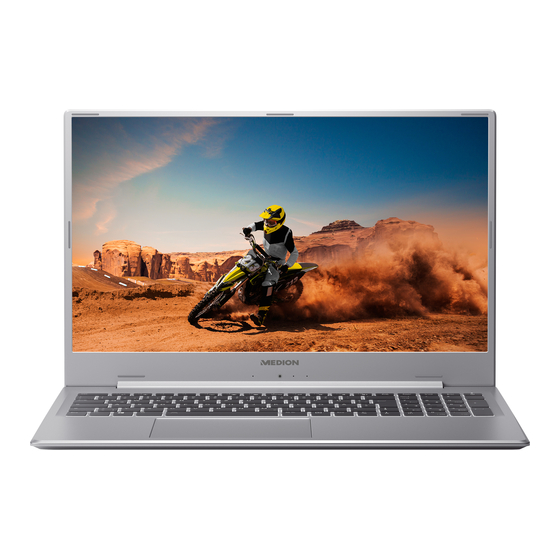
Table of Contents
Advertisement
Advertisement
Table of Contents

Summarization of Contents
Information about these Operating Instructions
Explanation of Symbols
Explains hazard symbols and their meanings for user safety.
EU Declaration of Conformity
Information on WLAN
Provides details on WLAN frequency range, standards, and encryption used by the notebook.
Safety Instructions
Dangers for children and people with reduced ability to operate electronics
Details risks for children and individuals with limited capabilities, emphasizing supervision.
Operational Safety
Provides essential instructions for safe and reliable operation to maximize device lifespan.
Never carry out repairs yourself
Warns against self-repair and advises contacting qualified personnel for maintenance.
Setup Location
Specifies suitable and unsuitable environments for setting up and operating the notebook.
Environmental Requirements
Details optimal operating and storage temperatures and humidity levels for the device.
Power Supply
Provides instructions and safety precautions for connecting and using the AC power adapter.
Notes on the Battery
Offers guidelines for proper battery usage, charging, and replacement to ensure performance and safety.
Cabling
Advises on safe cable management to prevent tripping hazards and damage.
Information about the Touchpad
Explains how to use the touchpad correctly and provides tips to avoid damage.
Protecting the Display
Offers advice on how to protect the sensitive display from damage due to stress or contact.
Data backup
Emphasizes the importance of backing up data before software updates to prevent loss.
Ergonomics
Provides guidance on ergonomic setup and practices to protect user's eyes and prevent fatigue.
Views and description of the controls
Open Notebook
Identifies and describes the components visible when the notebook is open.
Bottom View
Identifies and describes the components located on the bottom of the notebook.
Right Side
Identifies and describes the ports and indicators on the right side of the notebook.
Left Side
Identifies and describes the ports on the left side of the notebook.
Power Supply
On/Off Switch
Details how to use the power button to turn the notebook on and off.
Preparation for Starting-Up
Starting the Notebook
Provides step-by-step instructions for the initial startup and setup process.
General Handling of Rechargeable Batteries
Battery Mode
Explains how batteries store and release energy and how to optimize performance.
Shipping Mode
Describes the shipping mode for battery protection during transport and storage.
Charging the Battery
Details the process of charging the notebook's battery using the AC adapter.
Quick Charging the Battery
Explains the feature for rapidly charging the battery to a specific capacity.
Discharging the Battery
Advises on how to discharge the battery and warns about potential data loss.
Battery life
Discusses factors affecting battery life and how power-saving functions influence it.
Power Management (Power Options)
Energy Saving Tips
Offers tips and settings for managing power consumption and extending battery life.
Display
Opening and Closing the Display
Explains how to open and close the notebook's display safely to avoid damage.
Data Input
Keyboard
Explains the notebook's keyboard layout and the use of function keys.
Specific Keyboard Shortcuts
Lists various keyboard shortcut combinations for quick access to functions.
Sound System
External Audio Connections
Explains how to connect external audio devices to the notebook.
Network Operation
Wi-Fi (Wireless Network)
Explains how to establish and use a Wi-Fi connection.
Requirements
Details the requirements and scenarios for using Wi-Fi access points.
Bluetooth®
Describes Bluetooth technology and its applications for wireless communication.
Card Reader
Inserting a Memory Card
Provides instructions on how to insert memory cards correctly to prevent damage.
Removing Memory Cards
Explains the correct procedure for removing memory cards from the reader.
Securing Your Notebook
Password Setting (Power-on)
Explains how to set a power-on password for enhanced security.
Kensington Security Lock
Details how to use a Kensington security lock to prevent notebook theft.
Fingerprint Sensor (optional)
Setting up the fingerprint sensor
Provides step-by-step instructions for configuring the fingerprint sensor.
Resetting the notebook to its Factory Settings
System recovery with PowerRecover (optional)
Details the process of using PowerRecover for system recovery and data backup.
System Restore with Windows Recovery Options
Guides on using Windows recovery options to refresh or reset the notebook.
How to Refresh your Notebook
Explains the steps to refresh the notebook while keeping personal files.
How to Reset your Notebook
Details the steps to reset the notebook, removing all data.
UEFI Configuration
Executing the UEFI Configuration
Describes how to access and run the UEFI configuration utility.
Customer Service
What To Do in Case of Hardware Problems
Offers initial troubleshooting steps for hardware malfunctions.
Find the Cause
Suggests checking cable connections as a first step in troubleshooting.
Do You Need More Help?
Guides users on how to contact customer support and what information to prepare.
Driver Support
Explains driver updates and where to find current drivers for the notebook.
Transport
Provides important information and precautions for safely transporting the notebook.
Cleaning and Maintenance
Offers detailed instructions and warnings for cleaning and maintaining the notebook.
Storage when not in use
Provides guidance on storing the notebook properly for extended periods.
Automatic Battery Protection
Explains how to activate automatic battery protection in UEFI for long-term storage.
Upgrading/Modifying and Repair
Notes for Service Technicians
Provides specific notes for service technicians regarding repairs and ESD precautions.
Information on Display Errors
European EN ISO 9241-307 Class II Standard
Details the EN ISO 9241-307 standard for display pixel defect classification.
















Need help?
Do you have a question about the MD62469 and is the answer not in the manual?
Questions and answers